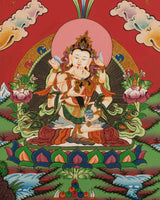
Vajrasattva Shakti Thangka | Religious Wall Decor

100% AUTHENTIC

HANDMADE

FREE SHIPPING
Vajrasattva Shakti Thangka
About Thangka
In Tibetan, Buddhism Vajrasatva is associated with the sambhogakāya and purification practice.
In the Shingon Buddhist lineage, Vajrasatva is traditionally viewed as the second patriarch, the first being Vairocana Buddha. According to Kukai's writings in Record of the Dharma Transmission, he relates a story based on Amoghavajra's account that Nagarjuna met Vajrasatva in an iron tower in southern India. Vajrasatva initiated Nagarjuna into the abhiseka ritual and entrusted him with the esoteric teachings he had learned from Vairocana Buddha, as depicted in the Mahavairocana Sutra. Kukai does not elaborate further on Vajrasatva or his origins.
His left-hand holds a bell, which rests on his hip, this is an expression of his compassion. The hundred-syllable mantra associated with him is used in all schools of Tibetan Buddhism for the purification of the mind.
------------------------------------------------------------------
Size: 10"/ 25 cm (width) x 13"/ 33 cm (height)
Materials: Cotton Canvas, Acrylic Colors, Genuine 24K Gold
------------------------------------------------------------------
THIS THANGKA IS HAND-PAINTED IN THE TRADITIONAL STYLE AND THE QUALITY IS HIGH
------------------------------------------------------------------
How does Thangka benefit us?
It goes without saying that every detail of a painting has a symbolic meaning. Regardless of your religious affiliation, a thangka can help you on your path to enlightenment, whether you practice Buddhism or have other religious convictions. Thangkas are paintings that depict deities with various iconographic elements and symbolism that encourage meditation on the teachings of the god they depict. Any thangka is intended to aid in the removal of the film of ignorance, which is a significant barrier to the road to enlightenment.
Shipping & Returns
We ship worldwide. Orders dispatch in 2–3 business days. International delivery typically arrives in 4–10 business days via DHL Express, depending on destination and carrier conditions. All items ship free globally.
Returns are accepted within 14 days of delivery. Products must be returned in original condition for a refund to be issued once received and inspected. Terms and conditions apply.











